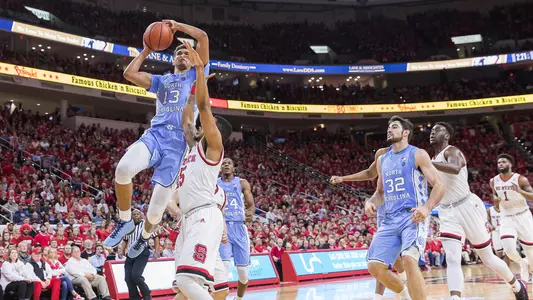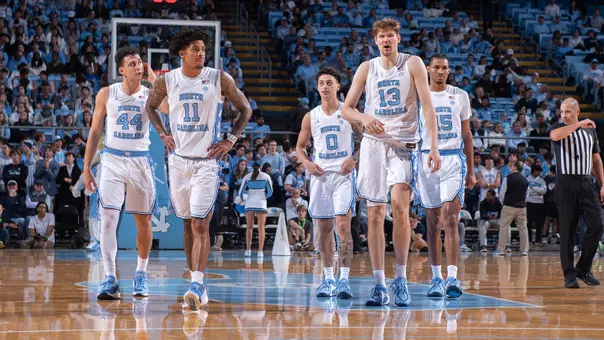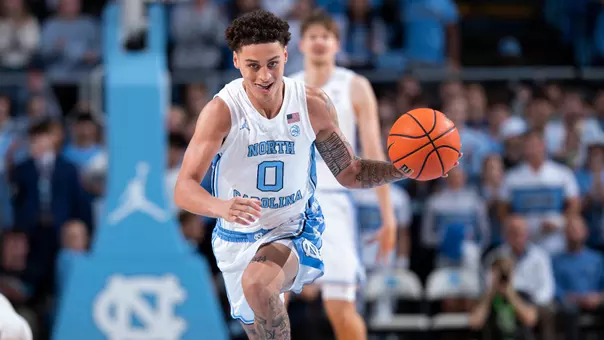University of North Carolina Athletics

Photo by: J.D. Lyon Jr.
Lucas: Road To Recovery
February 12, 2018 | Men's Basketball, Featured Writers, Adam Lucas
The recovery process has been key in Carolina's grueling stretch.
By Adam Lucas
Carolina's preparation for NC State began late Thursday night while Franklin Street was still raging with joy after the win over Duke.
While students shouted and celebrated, multiple Tar Heels made their way to the cold tub in the players' area of the Smith Center. Chilled to 50 degrees, it is a startling experience. Imagine the worst cold shower you've ever taken in your life, and then imagine staying submerged in it for 12 minutes.
And that's where the preparation began.
Carolina's unique three games in five days cycle of games has been well publicized. What hasn't been quite as well chronicled is the way the Tar Heels have prepared physically for the strenuous stretch.
Strength and conditioning coach Jonas Sahratian and trainer Doug Halverson first have a very simple requirement for the players, especially the five starters. Joel Berry has played 72 of a possible 80 minutes in the last two games. Luke Maye has played 69 minutes, Kenny Williams 67, Cameron Johnson 66, Theo Pinson 59.
After every game, Sahratian makes the rounds of the locker room, asking the players to rate on a scale of one to ten how far they feel they pushed their bodies. It's essentially a measure of how close to their physical capacity they feel the last two hours have taxed them. It's not unusual for some early season games to rate a six. After Saturday's 33-point, 17-rebound game against NC State, Luke Maye declared it a nine.
The skeptic says they're kids, that they should be able to play all day, that when-I-was-a-kid-I-played-outside-for-hours-and-never-complained. But understand: these are hard, ACC minutes, replete with lots of contact and hard fouls and endless running at a Roy Williams-mandated pace. So the first strategy for being prepared is very basic.
"The first thing we tell them," Tar Heel trainer Halverson says, "is they have to do the basics. They have to eat, they have to get sleep, and they have to hydrate."
Even the head coach has to contribute to the preparation. On Friday, the Tar Heels had a 20-minute meeting and were on the court for an hour and three minutes. Only one element of the on-court session was full-court, with the rest half court. Williams planned the same format for Sunday's practice before Monday's game with Notre Dame.
And then he relies on Halverson and Sahratian to do everything possible to get his players' bodies ready to play at a high level on game night. Two of the biggest components of the recovery process are soft tissue therapy (you might have seen the Tar Heels using foam rollers) and cold tubs. Thursday night, that meant multiple Tar Heels were in the Smith Center cold tub within an hour of the final buzzer against Duke.
"We're trying to get them in there and cool them down," Halverson said. "We want to stop the inflammatory response from the game and the workout and try to start the clock on the recovery as quickly as possible. We know they are going to tighten up and feel stiff. How can we keep them feeling loose?"
It's remarkable how far the idea of recovery has come in a decade. In 2008, I spent an hour with Tyler Hansbrough after a game to catalog his postgame routine. There's this perception that Hansbrough was successful purely because of physical talent. That played a factor, but he was also well ahead of his time in taking care of his body. Reading that story today is like a glimpse inside a time capsule (he was using an iPod), but also not that different than what players are asked to do in 2018 (It should also be noted how far ahead Sahratian was; back in 2008, he was telling players Hansbrough was treating his body the right way).
At the time, Hansbrough's teammates thought his routine was a little crazy. Now, it's largely a part of everyday life.
Hansbrough once took his cold tub in what looked like an overgrown aluminum bowl. Now, players relax in dual cold and warm tubs which—as Hansbrough was no doubt happy to see when they were installed—include flat screen televisions so they can watch every moment of that day's games.
Ten years later, it's playing a major role in helping the Tar Heels play a grueling stretch of the season that hasn't been required as part of the regularly scheduled season since 1980.
"Jonas and I have a pretty high bar for what we ask of them in terms of taking care of their bodies," Halverson says. "The thing about this team is that when you look at our leaders, they're also the ones who are first in the weight room and the training room to get ready for a practice, and the last one to leave. They've set a good example for our young guys from October until now. That's why they're succeeding. They prepare the right way, and set an example for everyone else to do the same thing."
Carolina's preparation for NC State began late Thursday night while Franklin Street was still raging with joy after the win over Duke.
While students shouted and celebrated, multiple Tar Heels made their way to the cold tub in the players' area of the Smith Center. Chilled to 50 degrees, it is a startling experience. Imagine the worst cold shower you've ever taken in your life, and then imagine staying submerged in it for 12 minutes.
And that's where the preparation began.
Carolina's unique three games in five days cycle of games has been well publicized. What hasn't been quite as well chronicled is the way the Tar Heels have prepared physically for the strenuous stretch.
Strength and conditioning coach Jonas Sahratian and trainer Doug Halverson first have a very simple requirement for the players, especially the five starters. Joel Berry has played 72 of a possible 80 minutes in the last two games. Luke Maye has played 69 minutes, Kenny Williams 67, Cameron Johnson 66, Theo Pinson 59.
After every game, Sahratian makes the rounds of the locker room, asking the players to rate on a scale of one to ten how far they feel they pushed their bodies. It's essentially a measure of how close to their physical capacity they feel the last two hours have taxed them. It's not unusual for some early season games to rate a six. After Saturday's 33-point, 17-rebound game against NC State, Luke Maye declared it a nine.
The skeptic says they're kids, that they should be able to play all day, that when-I-was-a-kid-I-played-outside-for-hours-and-never-complained. But understand: these are hard, ACC minutes, replete with lots of contact and hard fouls and endless running at a Roy Williams-mandated pace. So the first strategy for being prepared is very basic.
"The first thing we tell them," Tar Heel trainer Halverson says, "is they have to do the basics. They have to eat, they have to get sleep, and they have to hydrate."
Even the head coach has to contribute to the preparation. On Friday, the Tar Heels had a 20-minute meeting and were on the court for an hour and three minutes. Only one element of the on-court session was full-court, with the rest half court. Williams planned the same format for Sunday's practice before Monday's game with Notre Dame.
And then he relies on Halverson and Sahratian to do everything possible to get his players' bodies ready to play at a high level on game night. Two of the biggest components of the recovery process are soft tissue therapy (you might have seen the Tar Heels using foam rollers) and cold tubs. Thursday night, that meant multiple Tar Heels were in the Smith Center cold tub within an hour of the final buzzer against Duke.
"We're trying to get them in there and cool them down," Halverson said. "We want to stop the inflammatory response from the game and the workout and try to start the clock on the recovery as quickly as possible. We know they are going to tighten up and feel stiff. How can we keep them feeling loose?"
It's remarkable how far the idea of recovery has come in a decade. In 2008, I spent an hour with Tyler Hansbrough after a game to catalog his postgame routine. There's this perception that Hansbrough was successful purely because of physical talent. That played a factor, but he was also well ahead of his time in taking care of his body. Reading that story today is like a glimpse inside a time capsule (he was using an iPod), but also not that different than what players are asked to do in 2018 (It should also be noted how far ahead Sahratian was; back in 2008, he was telling players Hansbrough was treating his body the right way).
At the time, Hansbrough's teammates thought his routine was a little crazy. Now, it's largely a part of everyday life.
Hansbrough once took his cold tub in what looked like an overgrown aluminum bowl. Now, players relax in dual cold and warm tubs which—as Hansbrough was no doubt happy to see when they were installed—include flat screen televisions so they can watch every moment of that day's games.
Ten years later, it's playing a major role in helping the Tar Heels play a grueling stretch of the season that hasn't been required as part of the regularly scheduled season since 1980.
"Jonas and I have a pretty high bar for what we ask of them in terms of taking care of their bodies," Halverson says. "The thing about this team is that when you look at our leaders, they're also the ones who are first in the weight room and the training room to get ready for a practice, and the last one to leave. They've set a good example for our young guys from October until now. That's why they're succeeding. They prepare the right way, and set an example for everyone else to do the same thing."
Players Mentioned
WBB: Post-Elon Press Conference - Nov. 6, 2025
Friday, November 07
Hubert Davis Pre-Kansas Press Conference
Thursday, November 06
UNC Field Hockey: Tar Heels Drop Duke, 5-2, for Spot in ACC Final
Thursday, November 06
MBB: Hubert Davis Pre-Kansas Press Conference
Thursday, November 06




.png&width=36&height=36&type=webp)













